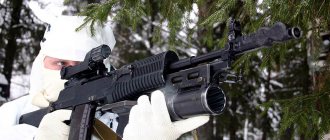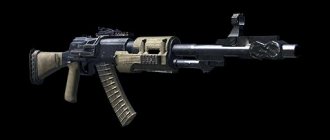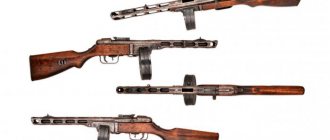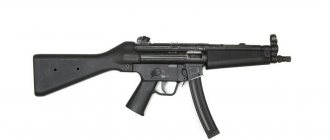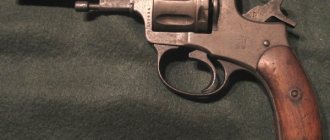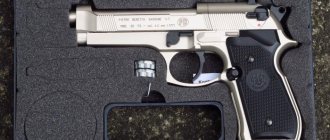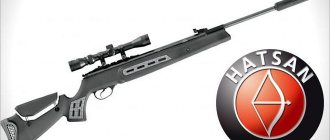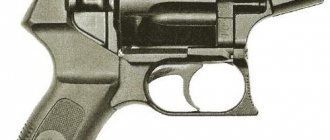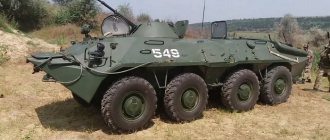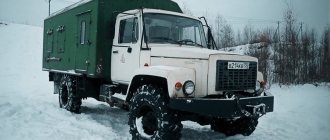PPS: submachine gun for total war
In 1942, the Soviet gunsmith designer Alexei Ivanovich Sudaev developed a new weapon, which many experts would later call the best submachine gun of the Great Patriotic War. We are talking about 7.62-mm submachine guns of the Sudayev system of the 1942 and 1943 model, the famous PPS. In total, during the war years, more than half a million Sudaev submachine guns of both modifications were produced.
At the time the design of the new submachine gun began, the Red Army already had the famous PPSh-41 in service, which proved to be an excellent and effective weapon in combat, as well as technologically advanced in production. At the same time, the PPSh also had its drawbacks, which included its large mass and dimensions, which made it difficult to use the weapon in cramped conditions of narrow trenches, as well as by tank crews, paratroopers and reconnaissance officers. At the same time, in wartime conditions, there was an urgent task to reduce the costs of mass production of such models of small arms.
PPS-42 and PPS-43
Already in 1942, a competition was announced for a more compact, lighter and cheaper to produce submachine gun, which in its characteristics should not be inferior to the submachine gun designed by Shpagin. In addition to Shpagin and Sudaev himself, other gunsmith designers took part in the competition: Degtyarev, Korovin, Rukavishnikov, but the model of the submachine gun proposed by Alexey Sudaev won the victory based on the results of competitive tests. Field tests of the new weapon were successfully carried out on June 6-13, 1942 in parts of the Leningrad Front, after which serial production of the PPS was launched at the Sestroretsk Arms Plant in Leningrad.
It was also important that the production of the new model of the submachine gun was initially established in besieged Leningrad. Delivering any weapons to a city surrounded by the enemy was a difficult task. That is why it was important to establish the production of small arms inside the blockade ring using existing production facilities. At the same time, it was important to remember that many workers were evacuated, went to the front or died, including from the terrible blockade winter of 1941-42. They were replaced by boys and girls who not only had no experience in industry, but were also physically weak. It was simply difficult for them to cope with the production of the PPSh submachine gun in service. The new submachine gun of the Sudaev system was finally adopted for service at the end of 1942 under the designation PPS-42. The designer himself worked on this weapon while in the besieged city; it is no coincidence that among his awards was the medal “For the Defense of Leningrad.” Alexey Ivanovich Sudaev had a direct connection to the defense of the city on the Neva.
The PPS automatic system was built on a blowback design. 7.62×25 TT cartridges were used to fire the submachine gun. The weapon was fired from an open bolt. The trigger mechanism of the Sudaev system submachine gun allowed firing only in automatic mode. The safety was located in the front of the trigger guard; when turned on, it blocked the trigger rod and raised a bar with cutouts that blocked the cocking handle, rigidly connected to the bolt, in both the cocked and deflated positions. The safety could be moved to the forward firing position by pressing the index finger just before placing it on the trigger. In some modifications of the submachine gun, if it became necessary to lock the cocked bolt, the cocking handle could be inserted into an additional transverse groove on the receiver. The cocked bolt in this position could not break spontaneously even if the weapon fell from a height or received a strong blow. The barrel casing and the PPS receiver were a single part; they were made by stamping.
Sudaev submachine gun
The rational layout of the submachine gun and the bolt stroke length increased from 83 to 142 mm led to a decrease in the rate of fire to 600-700 rounds per minute. This made it possible to use a trigger mechanism that allowed only automatic continuous fire, and for firing single shots, for this the shooter had to smoothly press and quickly release the trigger. Firing in short bursts of 2-5 rounds was considered the most effective; when firing in long bursts, dispersion seriously increased. The destructive power of the bullet remained at a distance of 800 meters, but the effective combat distance using Sudayev’s submachine guns was 100-200 meters. Sighting devices were represented by a front sight and a sight with a reversible rear sight, which was designed for two fixed positions - 100 and 200 meters.
Sudayev's submachine gun was equipped with six magazines, which the fighter carried in two bags. They also contained the necessary spare parts: a double-necked oiler and a composite cleaning rod. The PPS-42/43 submachine guns were fed using box magazines with a capacity of 35 rounds of 7.62x25 TT cartridges. The magazines were inserted into the receiver (neck), which was equipped with a latch with a safety bracket, which prevented the possibility of accidental removal of the magazine. The cartridges exited the magazine in two rows; this not only increased the reliability of the weapon in combat conditions, but also simplified the process of filling the magazine with cartridges for the fighter.
The compactness of the PPS was ensured through the use of a folding metal stock, which has a fairly simple design. In the stowed position, it was simply placed on the receiver. Transferring from traveling to combat position took very little time. The presence of a pistol grip on the weapon made it possible to securely hold all models of the PPS during firing. With a loaded magazine, the PPS weighed just over 3.6 kg, while the PPSh-41 with a loaded box magazine weighed 4.15 kg.
Comparison of PPSh (left) and PPS (right) stores.
In 1943, the submachine gun was improved. The weight of the bolt was reduced from 570 to 550 grams, the barrel length was reduced from 272 to 251 mm, and the length of the folding stock from 245 to 230 mm. In addition, Sudaev improved the cocking handle, safety box, and shoulder rest latch. The receiver and barrel casing were combined into a single part on this particular model, designated PPS-43.
Along with its high service, operational and combat qualities, the teaching staff was also distinguished by its outstanding production and economic characteristics. The design of this submachine gun allowed the production of 50 percent of components and parts on press-stamping equipment using cold stamping using spot and electric arc welding. Compared to the PPSh-41, the new weapon was more economical to produce; its production required approximately three times less time and half as much metal. Thus, 2.7 man-hours and 6.2 kg of metal were spent on the production of one PPS-43 submachine gun, and 7.3 man-hours and 13.5 kg of metal were spent on the production of PPSh-41, respectively.
Today we can confidently say that the PPSh and PPS submachine guns made an invaluable contribution to the victory in the Great Patriotic War. These were small arms that could be mass-produced with the involvement of non-core enterprises of Soviet industry for their production, to a greater extent this concerned the Sudaev submachine gun, which was easier to produce. Reducing labor costs, greater technology and simplification of production in wartime conditions, when teenagers and women took over the machines at Soviet enterprises and factories (that is, unskilled labor was involved in production) were of great importance.
The son of a regiment with PPS-43 on the street of Budapest, photo: waralbum.ru
As historian Andrei Ulanov notes, weapons such as the Sudaev submachine gun were ideal for poorly trained fighters and were unpretentious in maintenance and use. Figuratively speaking, the PPS sprinkled with earth could be picked up, shaken off, the bolt pulled back and used again in battle. At the final stage of the war, the weapon performed well in battles in urban environments, where the combat distance was short. The Red Army, saturated by this moment with a large number of automatic weapons, primarily submachine guns, could conduct effective assault operations in cities. The PPS and PPSh submachine guns also proved effective in battles against the Japanese Kwantung Army in August 1945.
Due to the mass production of submachine guns, the Red Army hoped to increase the percentage of automatic weapons in the troops. At the same time, as Andrey Ulanov notes, the production of submachine guns during the Great Patriotic War was also profitable from a technological point of view. It turned out to be the easiest way to increase the production of such weapons in military conditions. First, the PPSh went into mass production, and from the end of 1942, an even more technologically advanced PPS was added to it. By the end of the war, their share in the troops was increased to 50 percent, which, of course, played a positive role. Submachine guns were ideal weapons for the Red Army during the war. They were technologically advanced, easy to produce, and could be produced in large volumes. Thus, about 6 million PPSh submachine guns were produced in the Soviet Union. In this regard, the PPS remained a more “niche” model, which especially appealed to armored vehicle crews, reconnaissance officers and paratroopers.
Motorcyclists of the Soviet 1st Czechoslovak Corps in the Carpathians. The soldiers are armed with submachine guns of the Sudayev system, photo: waralbum.ru
At the same time, the PPS was distinguished by its simplicity of design, lightness, compactness, and reliability in operation. In the armament of the tank, airborne, reconnaissance units, engineering units and partisans who were most in need of such weapons, the Sudaev submachine gun occupied a dominant place. With these small arms, Soviet units drove the enemy back from the suburbs of Leningrad and reached Berlin. The production of PPS continued after the war; in total, about two million copies of this submachine gun were produced. Until the mid-1950s, the PPS remained the standard weapon of the crews of Soviet armored vehicles and special forces - the Marine Corps and the Airborne Forces; it was in service with the rear, auxiliary units, internal and railway troops even longer. Moreover, after the war, PPPs were massively supplied to friendly countries in Eastern Europe, Africa, as well as to China and North Korea; in the latter two countries, their mass production was established with adaptation to local industrial realities.
Sources of information: https://www.bratishka.ru https://vpk-news.ru https://planet-today.ru https://www.armoury-online.ru Materials from open sources
Design
The PPS has a classic blowback design. The automatic mechanism is triggered by a massive bolt after the shot. The firing mechanism is located in the rear part. Due to the low rate of fire (up to 600 rounds per minute), the designers abandoned the idea of creating a single firing mode.
The shutter handle is on the right, which provides more convenient use of the weapon.
Sudaeva machine gun design
Combat accuracy and fire efficiency
To hit one target when firing in a short burst at a distance of up to 100 meters, one bullet is enough. If the enemy is 150 meters away - 2 bullets. If the distance is 200-250 m, then you need to spend 3 bullets.
These calculations take into account a soldier standing at full height.
Soldier with submachine gun Sudaev PPS
Saving
During the fighting, the country falls into crisis. There is not enough money to produce expensive models. Therefore, the new PPS machine gun had a much more economical design, which used fewer metal elements than the PPSh. This made it possible to reduce the cost of weapons in general. In addition, the percentage of waste in the production of these two submachine guns also differs greatly in favor of PPP (48%). For PPSh, the same figure was 60-70%. During the production of the new machine gun, both stamping and welding were widely used, and the PPS-43 itself was made of metal almost entirely, excluding only the handle linings, which were made of wood; later plastic was also used.
Development and production
Modifications
A total of 7 modifications of this weapon were created.
- PPS-42.
- PPS-43.
- The Finnish military conducted an analysis of the Soviet teaching staff and ultimately decided to modernize it and put it into service. This is how the m/44 turned out, which was filled with 9x19 mm Luger-type cartridges. In total, approximately 10,400 units were created, which were used until 1958, in which Finland carried out a peacekeeping mission in the Sinai Peninsula from the UN.
- In Germany, weapons were produced in small quantities under license for Spain and West Germany. The weapon bore the designation DUX-53. From 1953 to 1959 it was in service with border control.
- In the Polish People's Republic a copy of PPS-43 was produced, and then PPS wz.1943/1952. The modification included the presence of a non-folding wooden stock. Polish literature also mentioned a .22LR training variant.
- The Chinese version was called "Type-54". Received minor changes due to the characteristics of the Chinese industry.
- Production was established in the DPRK after World War II.
Since the design of the weapon is very simple, it was often taken for the production of various firearms in a handicraft way. An example is the Georgian Zugdidi plant, which produced Iveria submachine guns, which is structurally very similar to the PPS. Similar weapons were also made in Nagorno-Karabakh.
PPS-43 submachine gun
Device for firing from cover
In 1946, Makarov developed the TKB-401 bender for the PPS-43 7.62 mm. This element made it possible to fire from cover. Externally, it looked like an ordinary trunk, which was bent 90 degrees. It was assumed that it would be installed on armored vehicles using a ball joint.
Automatic shooting
The safety is located near the trigger guard. If you pull the lever back, the trigger rod will lock and you won’t be able to shoot. To remove the safety lock, you just need to push the lever forward with your finger.
On a note! Thanks to the low rate of fire, it is possible to fire single shots. This is achieved due to the long shutter stroke.
The ammunition magazine has a curved shape that holds 35 rounds. The magazine is secured with latches. The design is made in such a way that the risk of accidental removal of ammunition is eliminated. The bullets in the magazine are placed in two rows, which significantly increases capacity.
Operation and combat use
During the Second World War
During World War II, PPP was used very widely in different countries.
- In the USSR, this weapon was in service. It was also supplied to partisans and foreign military formations on the territory of the Soviet Union.
- Captured weapons were supplied to German soldiers and satellites of the Third Reich.
- The Finns used the PPS-42 and PPS-43 mostly for reconnaissance, but later the weapon underwent some changes and was widely used.
- In 1944, the USSR began supplying PPS-43 to Yugoslavia for the People's Liberation Army. There the weapon was called Automat 7.62 mm PPS M43(s).
After the end of World War II
After the end of World War II, the weapon remained in the arsenal of many countries for a long time.
- In the DPRK, a Soviet and Chinese-style submachine gun was in service until 1997.
- In Poland, PPS-43 and an analogue produced in Poland were in service until the mid-1980s. For a long time it was used by the police and security services.
- In Ukraine, PPS-43 began to be widely used not only by the military, but also by the police in the early 1990s. This was due to the increased crime situation. It was not possible to issue a Kalashnikov assault rifle instead of the PPS, since there was a shortage of 5.45x39 mm cartridges. In 2005, there were about 25,000 units in storage. By August 2011, this number had dropped to 18,000. During the conflict in southeastern Ukraine, the use of PPS-43 was recorded.
- Laos also used the Sudaev submachine gun for a long time.
Escapement mechanism
The PPS (automatic) has an interesting design. The release mechanism, like most of the parts, is extremely simple. It consists simply of a trigger and a lever, which are connected by an axis. A mechanism is integrated with the trigger box latch. They also have a fuse attached to them. The latch locks both boxes in the closed position. The safety device is created in the form of a plate, which is located on the right wall of the trigger box (on its inside).
This position allows you to simultaneously block the trigger mechanism, lock the connecting axis, and lock the bolt. The latter is fixed in the position in which it was when the submachine gun was put on safety. There are two positions here: front and back. In the first, the bolt is secured by the end of the safety plate, which rests against the handle on the reverse side. In the rear position, the bolt handle is secured in the middle part. Thus, a fuse is a device that is controlled by a plate. The machine itself stands on it after moving the handle down and up.
The magazine latch, which is located in front of the trigger guard, is covered with a bracket welded to the neck. It prevents you from accidentally pressing the latch, but at the same time it is intended for convenience. The PPS-43 assault rifle is very functional, its parts often perform several roles, this ensures simplicity of design, and, therefore, speeds up production. It is unlikely that you will be able to create a PPP (automatic machine) with your own hands - this requires special conditions and equipment.
Appearance and equipment
When designing the teaching staff, no attention was paid to appearance, since at that time it was not important. The weapon is completely made of metal, but its weight has not increased. The barrel casing is one-piece with the receiver. The lower part of the casing is completely open along its entire length. All parts are connected to each other by welding seams and rivets.
The sight consists of a front sight, which is covered with ring-shaped earpieces. The latter are needed to protect the front sight from impacts. The second element of the sight is the rear sight.
Characteristics
The machine's magazine includes 35 rounds, just like the PPSh. However, the Sudaev PPS assault rifle has a different design for this device. So, it does not have ridges (ribs) and some other parts found on the PPSh magazine. This, by the way, greatly reduces the weight of the entire machine and makes it more technologically advanced. Weight without magazine (260 g without equipment) is about 3 kg. The total weight of the PPS with cartridges is 3.62 kg. The barrel length is 0.25 m. The bolt weight is about 0.5 kg. Each sample comes complete with 6 magazines, which are carried in bags. Their weight together with the PPS machine gun is 6.82 kg. This is a good indicator.
The real weapon of victory - the PPS-43 assault rifle - has become a legend. PPSh and PPS assault rifles are great weapons. They are credited with a great contribution to the liberation of Leningrad. However, until the end of the Great Patriotic War, PPSh was produced in larger quantities than PPS. Historians and experts call this submachine gun the best among all weapons of this type of those times. PPS-43 includes all the technical innovations of that time and at the same time remains easy to use and manufacture.
